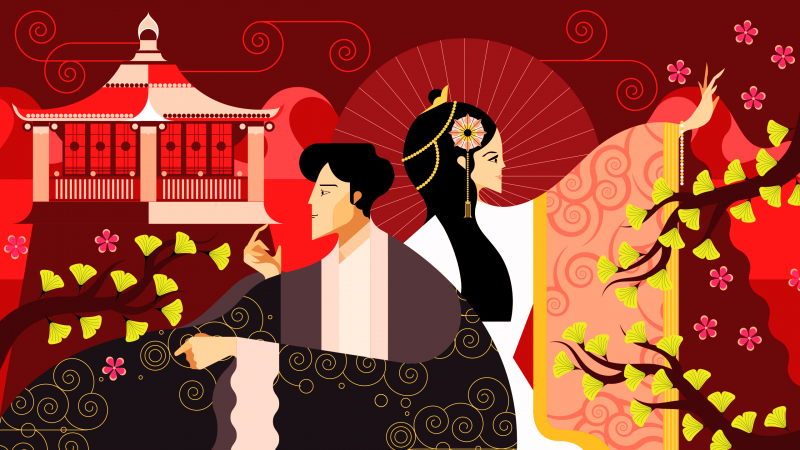Hanfu
One of the traditional styles of Chinese clothing is called hanfu, which translates to "Han clothes." It was banned at the start of the Qing Dynasty after more than three millennia of serving as the distinctive apparel for the Han ethnic group (1644–1912). Before the Qing Dynasty, when the Manchus ruled, the Han people wore what is referred to as "Hanfu," which was their traditional attire. When Chinese people refer to hanfu in recent years, they typically refer to a long, flowing robe with loose sleeves and a belt at the waist. However, the word "Hanfu" encompasses a wide range of clothing designs from several dynasties.
Hanfu has a loose yi (/ee/) "upper garment" with sleeves and a shang (/shung/ "lower garment") that resembles a skirt. Jade was frequently used to embellish the belt sash. It is seen as a representation of true Chinese culture, evoking the ritualistic, musical, and ethical values of Confucian intellectuals.
According to mythology, Hanfu dates back more than 4,000 years to the time that Leizu, the wife of the fabled Yellow Emperor (2698–2598 BC), began producing silk garments. However, no archeological proof has been found to back this idea.
Hanfu in the Xia and Shang Periods (2070–1046 BC)
Top-bottom clothing was popular during the Xia Dynasty (2070–1600 BC). The Shang Dynasty (1600–1046 BC) established the Hanfu's fundamental form. The yi was a knee-length tunic with small cuffs that was fastened by a sash. The shang was a brief skirt that reached the ankle. An apron called a bixi, which means "cover the knees," was worn outside. There were just two fundamental hues, red and green, due to outdated technology.
Hanfu in the Zhou Dynasty (1045 – 221 BC)
Kings of the Western Zhou Dynasty established a rigid hierarchical system based on blood ties and family-based ethical standards during the Western Zhou dynasty (1045–771 BC). Due to the significant distinctions between the nobles and the common people, clothing was employed as a status symbol to emphasize their privileges, which had a significant impact on clothing and ornamentation.
The Eastern Zhou period (770 – 221 BC) saw the emergence of Shenyi (one-piece garment) and Mianfu (religious court attire used by ancient emperors and officials). Hanfu sleeves were made wider, and a belt or jade ornaments were used to close the outer tunic. The crossover collar became visible. Clothing from other ethnic groups, such as hufu (clothing from northern ethnic groups such as the Huns), was formed and merged with Hanfu.
Hanfu in the Qin and Han Dynasties (221 BC – 220 AD)
The Hanfu's details were seldom changed during the Qin and Han dynasties. The shenyi was remained the preferred type of attire for both Han and Huns. A new type of formal attire, the pao (袍), a linen robe, predominated. During the Qin Dynasty, third-rank officials and higher were required to wear green silk pao and shenyi, while the common people wore white linen pao.
Hanfu in the Sui, Tang, and Song Dynasties (581 – 1279)
The Sui and Tang dynasties were "China's golden age," during which time the Han culture expanded. Based on their forefathers, a dress style combining Hanfu and Hufu components became popular. Because women were less constrained by Confucian ethical rules, their clothing grew looser and more exposed than their predecessors. The clothing of the Song Dynasty was essentially a continuation of the Tang Dynasty's style. More embellishments and needlework were added. Women of the Song Dynasty wore beizi (cape-like garments).
Hanfu in the Yuan Dynasty (1279 – 1368)
The Yuan Dynasty was China's first foreign-ruled dynasty. During this period, the Hanfu acquired elements of the Mongolian kings' national dress. Men wore both the classic Han-style round-collar pao and the Mongolian zhisunfu (jisum in Mongolian). This featured a knee-length yi (top garment) with thin sleeves and a short shang (lower garment).
Hanfu in the Ming Dynasty (1368 – 1644)
The Ming Dynasty was the final dynasty led by the Han. The emperor desired to revive the entire Han culture and tradition, including all Tang Dynasty dress trends. However, many Mongolian-style garments and headwear persisted, as did wardrobe alterations from the Song dynasty. Confucian norms were re-popularized, and women's clothing became more restrictive. The upper outer garment was made shorter, while the bottom garment was made longer, and the outer coat was made longer to minimize the length of the exposed skirt.
Hanfu in the Qing Dynasty (1644 – 1912)
When the Manchus took over China in 1644, there was a drastic shift in hairstyles and attire. At first, the Manchu leader compelled all Han people to wear the Manchus' long robe or cheongsam, but this restriction was soon relaxed. In the late Qing Dynasty, three forms of clothing coexisted: Han traditional garments (i.e. Hanfu), Manchu clothes, and half-Western-style clothes.
Hanfu's Influence in East Asia
Hanfu served as a metaphor for conventional Chinese culture. It also had a significant impact on the clothes of other Asian neighbors, such as the Vietnamese Áo giao lĩnh, Korean hanbok, and Japanese kimonos. In the fifth century, the Japanese began assimilating Chinese attire. The kimono is traditional Japanese attire. It is also known as gofuku, which means "Wu's garment." Wu was one of the Three Kingdoms of China (220–280).
Hanfu in Modern Times
After falling out of favor for more than 400 years, several Han ethnic groups called for a rebirth of Hanfu as part of a movement that the public should be proud of their Chinese culture. Wearing Hanfu, according to many enthusiasts, gives them a strong sense of national identity. Many Chinese institutions have a Hanfu Society whose members wear Hanfu to celebrate traditional Chinese festivals, and they take advantage of the opportunity to show off their Hanfu costumes to others.







